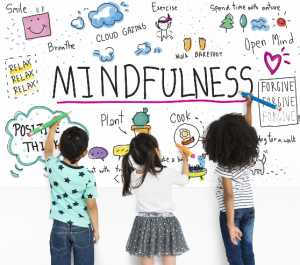
 What is Mindfulness?
What is Mindfulness?
Mindfulness is the practice of experiencing our thoughts and emotions without judgement. For example, if you feel any kind of negative emotion, you would acknowledge the emotion and let it pass. As a result, you won’t get caught up in one emotion. Mindfulness allows you to be present and react using your logical brain. Discover more about how mindfulness for kids can benefit them.
The many benefits of practicing mindfulness has been studied extensively in adults. In contrast, there is not as much research when it comes to how mindfulness can benefit kids. The research that does exist out there of mindfulness for kids shows promising results. In fact, many schools are setting up mindfulness rooms and incorporating mindfulness into their curriculum. Schools that develop mindfulness exercises for kids may be able to help assist students in their academic and personal lives.
What are the Benefits of Mindfulness for Kids?
Firstly, mindfulness can help kids remain calm when they experience anger. Ultimately, this can help them focus and make better decisions when they react. In fact, research shows that kids who practice mindfulness have better relationships. For example, schools that teach mindfulness can find a reduction in bullying and an increase in conflict resolution among students.
Tips to Teach your Kids Mindfulness
Keep it Easy to Understand
Mindfulness can be difficult for young children to comprehend.
Practice Mindfulness
It is almost always easier to teach someone else to do something when you have already done it yourself. For example, try to use mindfulness in your daily life. A good start is meditation daily. In fact, mindfulness can be as simple as pausing during the workday to smell fresh flowers. All it takes is a few moments to pause and take in the world around you.
Keep your Expectations Realistic
While mindfulness can help children better deal with and understand their own feelings, it does not stop normal kid behavior entirely. For example, your child will still have tantrums from time to time. To begin, try for five minutes a day or every other day. Importantly, small steps can cause a gradual improvement over time.
Don’t Pressure your Kids to Learn Mindfulness
For example, if your kids are simply not interested or struggling with mindfulness, it’s okay to take a break! As well as that, no one is going to learn something new very quickly. Importantly, it is important to delay lessons and pick them up at a later time if your child is feeling overwhelmed.
Mindfulness Exercises for Kids
1. Ring a Bell
One of the easiest ways to teach kids mindfulness is to listen to a bell ring. Have your kids listen closely to the sound.
2. Take a Mindfulness Walk
Next time you go on a walk with a child, try to make them more aware of their surroundings. For example, listen to the sound of a bird chirping or a dogs walking nearby. In addition, you can look at the clouds and make shapes out of them.
3. Teach Mindful Eating
Firstly, have your child focus on chewing each food carefully. Then, you can have them describe the texture, color, or flavor of the meal.
4. Create your own Weather Report!
An easy way to kids to identify their feelings is to describe them as if their feelings were the weather. This is helpful for two reasons. Firstly, it is simple and a good metaphor for how emotions work. Secondly, we cannot control our emotions and thoughts, just like we cannot control the weather. For example, children can define their emotions as dark clouds, sunny, windy, or rainy. Importantly, bad weather always passes.
5. Grab a Breathing Buddy
Firstly, many mindfulness exercises involve focusing on your breathing. Your child can grab a “breathing buddy” that can be one of their favorite toys. Then, have your child place the toy on their stomach. Lastly, have your child watch as their stomach rises and falls with each breath.
Mindfulness in Schools
Mindfulness tools have made such an impact, that many other schools are starting to incorporate mindfulness into their curriculum. For example, schools from elementary to collegiate level have built rooms dedicated to mindfulness in their building. In fact, mindfulness programs are relatively inexpensive to teach and can be quickly implemented.
For instance, some schools will teach yoga or meditation classes as a mindfulness activity. Also, teachers can have calm areas or spaces designated in the classroom for students to decompress. Many young students struggle to get back into the groove of things after transitions in school like recess or lunch. Importantly, mindfulness for kids can help them refocus and get ready to learn.
Results of schools who practice mindfulness look very promising. For instance, one study shows that students who practice mindfulness are able to focus, regulate their emotions, manage stress, have increased empathy, and an improved academic performance. In fact, other schools have found a reduce in bullying and conflict between students.
The idea behind why mindfulness works is because kids can learn how to stay calm when they are experiencing stressors such as not performing well on a test.
Mindfulness for Kids in Stressful Homes
Importantly, children who live in a stressful environment stand to benefit the most from mindfulness exercises. In fact, studies show that children in these situations are prone to being “on-edge” or anxious constantly. As a result, this sets them up for outbursts. This can lead to punishments like suspension. However, by practicing mindfulness, kids can better grasp their emotions and deal with any “fight-or-flight” feelings they have.
Mindfulness for Different Age Groups
You can start teaching mindfulness as soon as your child can understand it.
Firstly, elementary age children can engage in breathing exercises or complete a coloring book as a soothing, mindful activity. For example, one such breathing exercise is “blowing up a balloon.” This works by envisioning you are blowing up a balloon as a way to control your breath.
Secondly, teens or pre-teens can use apps or YouTube videos of guided meditations. This can help teens manage their academic and personal stress.
Furthermore, mindfulness is not just something for adults. Using mindfulness for kids benefits them in many ways.
To learn all about mindfulness for your specific needs, please visit www.mindfulness22.com which has a variety of amazing short videos to meet all your needs.
